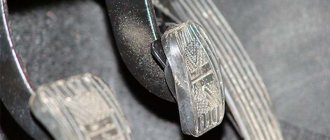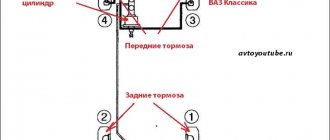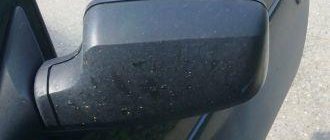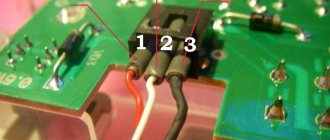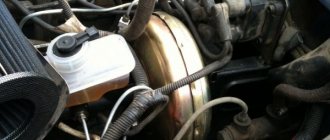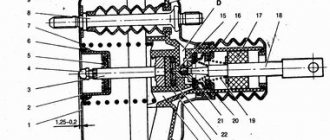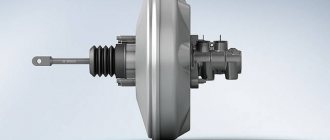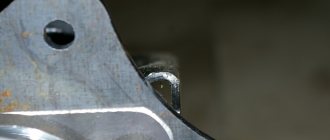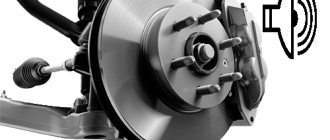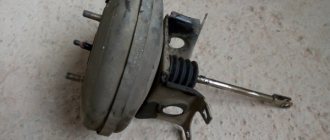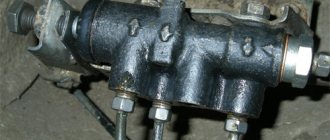Bleeding ABS brakes is essential for safe vehicle operation. After replacing the brake fluid, remove any remaining air from the system. The procedure for bleeding brakes with ABS confuses many drivers, since the process differs from that on cars where this system is not provided.
Have you ever needed the help of a car lawyer?
Not really
It is no more difficult to bleed a brake system with ABS than a conventional one. The main difference lies in the accumulator and valves, from which it is not so easy to remove air. However, if you have certain knowledge and skills, it is quite possible to bleed ABS brakes yourself, without the help of specialists from a service station.
Differences between ABS brakes
The main difficulty lies in ignorance of the nuances of operation and the main differences from the same procedure on conventional brakes.
Different car models have their own types of ABS, the design of which differs from each other. This leads to the fact that each brand of car has its own nuances of the system bleeding procedure.
Bleeding brakes with ABS has three main differences from conventional ones:
- the pipeline system in the presence of ABS is under increased pressure;
- During the procedure, constant monitoring of the brake fluid level will be required;
- the pump runs for no more than 10 minutes.
If you do not control the brake fluid level in the system, it will reach a critical minimum and the drive pump will begin to pump air.
This will quickly damage the device.
If the pump runs longer than the set 10 minutes, turn off the ignition and allow the unit to cool for 10-15 minutes.
Anti-lock braking system ABS: types, types
Depending on the type and type, ABS is classified into:
- One scheme of operation of the ABS system is when all the devices that make up the ABS are located in one unit. That is, the hydraulic valve block, hydraulic accumulator and pump are located in one unit.
- The second ABS scheme is when the component devices (hydraulic valve block, hydraulic accumulator and pump) are located in different places. In this type of braking system, in addition to the ABS module, there is also an ESP module and an SBC module.
Whether you can bleed the brake system yourself depends on what type of brake system is in your car.
If the car has a system of the first type, then it is easy to properly pump the ABS.
If the car has a system of the second type, then one cannot cope without a scanner; it needs to be pumped to a service center for maintenance.
The ABS system consists of:
How to properly bleed the brakes
First of all, look in the car manual to see in what sequence the pumping is carried out. If no recommendations are given, then the procedure is carried out in the form of English Z.
What you will need
You should invite an assistant who will press the brake pedal on command.
A rubber hose, a set of spanners, brake fluid and a container for draining it are also prepared.
Brake system design
The Priora brake system includes the following elements:
- master brake cylinder;
- fluid reservoir;
- piping system;
- working cylinders – 4 pcs.;
- brake drums;
- master cylinder vacuum;
- brake pedal.
As on all cars, the brakes on the Priora are pneumohydraulic. What it looks like in practice. The main part of the brake system is the master cylinder. It is located in the engine compartment. A container with an oily liquid is connected to it. It is called “braking”. The main brand used on Priora was Dot. It is widespread among Russian car enthusiasts and is well known to those who have tried to bleed the brakes. The master cylinder is filled with this liquid and acts like a syringe. When you press the brake pedal in the cabin, the piston of the master cylinder pushes the fluid in it into the pipeline system. Those, in turn, are connected to the working cylinders. Acting on the same principle, the working cylinder forces the locking pads to compress or, conversely, depending on the type of brake, to unclench, stopping the rotation of the wheels.
Step by Step Actions
The nuances of pumping depend directly on the ABS model. The location of individual components and the presence or absence of additional modules affect the order of the procedure.
The preparatory stage is the same regardless of the car brand. Turn off the ignition and press the brake pedal intensely several times.
Pumping using the example of Lada Granta
The car is placed on an overpass or driven into a pit. This is necessary so that you do not have to remove the disks for free access to the working surface. Next, turn on the ignition to open the solenoid valves. Start the procedure with the right rear wheel.
To bleed the brakes you need:
- Disconnect the wires from the tank cap;
- remove the cover;
- pour brake fluid into the reservoir (as much as will fit);
- remove the cap;
- use a spanner wrench to loosen the tension on the fitting;
- the prepared hose is connected to the tip of the fitting;
- place the second end of the hose in a container for waste liquid;
- press the brake pedal several times;
- fix the pedal in the lowest position and hold it;
- use a key to open the fitting;
- wait until the liquid has completely drained (at this moment the brake pedal will “fall” to the floor);
- close the fitting;
- pump the pedal again and repeat the procedure until the liquid flowing from the hose no longer contains air bubbles;
- tighten the fitting;
- remove the hose;
- reinstall all parts.
The process is repeated on each wheel in order of priority.
Bleeding the brakes of Lada Priora
The process of bleeding the ABS brake system for the Lada Priora is similar to the previous one. When bleeding the front wheels, the discs are removed, providing better access to the working surface.
After completing the process, you should not immediately drive out onto the road. First, they check the functionality of the system in a safe area, eliminating leaks and failures of the pedal.
Bleeding brakes on Lada Priora
After servicing or repairing the brake system of a Lada Priora, it is necessary to bleed the hydraulic brakes to remove excess air. I don’t think it’s worth talking about what the consequences may be if you ignore this procedure.
Signs of air getting into the brake system hydraulic drive:
– when you press the pedal once – increased pedal travel, its “softness”;
– with repeated pressing of the pedal - a gradual decrease in the pedal stroke with a simultaneous increase in its “hardness”.
Before bleeding the hydraulic drive, it is necessary to identify and eliminate the cause of depressurization.
Helpful advice.
If pumping a hydraulic drive is associated with the repair of one circuit and the serviceability of another circuit is known, then pumping only the circuit being repaired is permissible.
Sequence of bleeding the brakes:
– rear right;
– front left;
– rear left;
- front right.
You will need:
"8" wrench, rubber hose, container for collecting brake fluid.
Self-bleeding brakes on Lada Priora
1. Check the level and, if necessary, add brake fluid to the master cylinder reservoir to the “MAX” mark.
Attention.
Only add brake fluid of the same grade as that used in the system.
Please note that on our website there is already a publication about bleeding the brake system of a VAZ 21099 with your own hands.
2. Place the vehicle on an inspection pit or lift.
3. If the rear wheels are suspended, first unlock the rear brake pressure regulator by inserting a screwdriver between the plate and the piston. Don't forget to remove it when finished.
4. Clean the air release valve on the brake mechanism from which air is supposed to be removed from dirt and dust.
5. Remove the protective cap from the air release valve.
6. Place the rubber hose over the valve head and immerse the end in a clean, transparent container partially filled with brake fluid (the end of the hose should be immersed in the fluid).
7. An assistant must sharply press the brake pedal 4–5 times (with an interval of 1–2 s between presses). After the last swing, you need to keep the pedal pressed.
8. Unscrew the air release valve 1/2 to 3/4 turn. Air bubbles will be visible in the liquid flowing from the hose. When the fluid stops flowing from the hose, close the air release valve completely, after which the assistant should release the brake pedal.
9. Repeat steps 7 and 8 until there are no air bubbles in the flowing liquid. At the same time, monitor the brake fluid level in the reservoir and, if necessary, add fluid, not allowing the level to drop below the “MIN” mark.
10. Remove the hose, wipe the air release valve fitting dry and put the protective cap on it. Bleed the brakes of the remaining wheels if necessary.
Notes.
Do not reuse brake fluid that was drained when bleeding. If the brake system hydraulic drive is not pumped thoroughly enough, then when you press the pedal at the end of its stroke, you will feel an increased “softness” of the pedal.
Recommendation.
There are two ways to bleed the hydraulic brake system without an assistant. The first is the most reliable: order a turner an aluminum or bronze cover for the main brake cylinder, screw the valve from the camera into it and connect it to the spare wheel with an additional hose; air pressure should not exceed 0.05–0.07 MPa (0.5–0.7 kgf/cm2). The second is not very reliable, but acceptable: connect the rubber bulb to the wheel cylinder fitting - the connection should be very tight. Squeeze the bulb, unscrew the fitting; When the bulb is half full, tighten the fitting. Repeat the procedure three to four times. During test braking, check the operation of the brakes.
Do-it-yourself brake bleeding on the Lada Priora has been successfully completed. Let us remember that the previous article was about replacing the wheel bearing on a Lada Priora.
Possible mistakes
In order for the procedure to be effective and not lead to new problems, you should know common mistakes. The most common ones include:
- mixing two different brake fluids;
- reducing the fluid level in the system to critical;
- pressure too high.
If you mix two brake fluids with different parameters, the rubber seals are damaged. The system becomes clogged with clots and stops working.
When the fluid level in the reservoir is too low, air gets into the brake system and it fails. Also, do not use excessive force when pumping. The recommended pressure in the tank is 0.8 atmospheres. If excessive pressure is created, the tank will leak.
Features of brakes with ABS (anti-lock braking system)
After the creation of the first hydraulic brakes, it soon became clear: completely jamming the wheels with pads does not improve braking performance at all. Moreover, it creates dangerous drifts. At first, drivers were taught jerk braking, that is, not keeping the pedal pressed constantly, but “pumping” by releasing and pressing the pedal with high frequency. The method is not very effective, because in critical situations, most drivers press the brake pedal firmly to the floor. And the same ABS was developed that is found on many Priora models.
Operating principle of ABS
The basis of ABS, as in all systems of modern cars, is a computer. It is he who controls all the actions of the anti-blocker. ABS is practically built into the Priora braking system. The fluid from the main cylinder enters the “hydraulic unit”, in which the ECU (electronic control unit), pressure control valves and ERP (electric return pump) are mounted. In accordance with the signals from the wheel speed sensors, the ECU opens and closes the valves and, releasing pressure, creates the very necessary jerky “pumping” effect. Even if the driver presses the pedal without releasing it.
